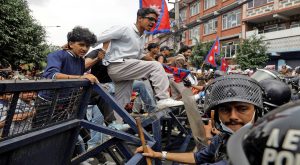
NEW DELHI (India), October 3— Ravi, a member of ICWP, routinely takes Red Flag to the Seemapuri area of New Delhi. Overcrowded Seemapuri, where just one water tap serves hundreds of residents. Many immigrants work in garment and leather factories. The air quality is so poor that one in three residents has a severe lung infection.
In early August, Ravi told his collective that a regular Red Flag reader from Nepal said, “Something big is going to happen very soon.”
Indeed, less than a month later, young Nepalese schoolchildren in their uniforms stormed out of their classrooms, joined by unemployed “Gen Z” youth. They poured into the streets of Kathmandu. It started as a trickle and became a massive revolt not seen in the history of Nepal.
The traditional newspapers had no clue what was going to happen. The Nepali ruling party was looking forward to a thumping majority in the next elections, months away. K.P. Oli, the Nepali prime minister, was so sure of his political grip that he dashed to the Shanghai Cooperation Organisation meeting in China.
Six days after visiting President Xi of China, Oli was humiliated and forced to resign. The parliament building, his own palaces, and major media outlets that had supported the government were all in flames and gutted to the ground. Several of his cabinet ministers narrowly escaped the masses’ wrath.
It was the first political experience for most of the thousands of youths who faced impenetrable barricades in the streets of Kathmandu. Undeterred by volleys of tear gas and water cannon, the masses pushed the barricades. Outnumbered cops fled for their lives, killing dozens in their retreat.
The young people didn’t panic. Instead, they set up mobile clinics, worked their TikTok accounts, and urged the masses to storm the centre of repressive state institutions. Hundreds of thousands followed them to the “Himalayan Uprising”.
Quantity Can Quickly Turn into Quality
Comrades in Ravi’s collective invited the Nepali immigrant and his friends to a special ICWP meeting about Nepal. We acknowledged the comrade who recognized that Nepal was changing rapidly. We learned that quantity can quickly turn into quality. However, there are signs of quantitative changes that the capitalist class does not see or is in denial about.
Our comrade from Nepal saw that the masses were restive. He saw that thousands of them were forced to go to the Gulf countries seeking slave jobs with horrific conditions. He saw that many thousands of Nepalese youths were promised lucrative jobs in Russia and Ukraine to fight wars. Many of them have been killed.
Mass unemployment in Nepal has forced millions to look for work in other countries. Many descendants of Nepalese who supported the British in World War II stopped receiving veterans’ benefits due to the crisis in the UK. Making matters worse, the Indian government, which once recruited tens of thousands of Nepalis to the Indian armed forces, started restricting them to give preference to the Hindu right-wing parties.
Masses saw this widespread discontent. But the ruling class media was busy spreading lies about youth escaping poverty in the Gulf states or mercenaries coming home from Russia with loads of money. The masses, disconnected from traditional newspapers, relied on social media outlets to express their frustrations and eventually to organize themselves to take to the streets.
Opportunities for Communism as Rebellion Spreads to India
India is ripe with opportunities as Modi tries desperately to sell the masses to fight for lower wages, unemployment, the climate crisis, and wars. A month after the uprising in Nepal, in the Indian state of Sikkim, which borders Nepal, hundreds of thousands of people took to the streets and burned down the BJP headquarters. The state government ruthlessly cracked down, trying to prevent Sikkim from becoming another “Gen-Z insurrection” after Nepal.
“A spark can ignite a prairie fire.” This is what our comrade from Nepal saw when he said ‘something big’ was coming. It reinforces our thinking that we must learn from the masses and listen to them.
The masses in Nepal were ready to start a prairie fire. It is now time for us to organize for a communist revolution. We are in a better position in India. We need to form more collectives and recruit comrades so they can turn opportunity into revolution. We will meet with our comrades from Nepal, distribute Red Flag, and recruit them.
Read our manifesto: Mobilize the Masses for Communism here

